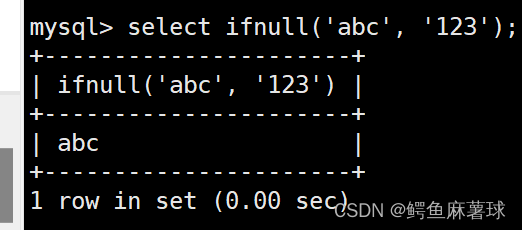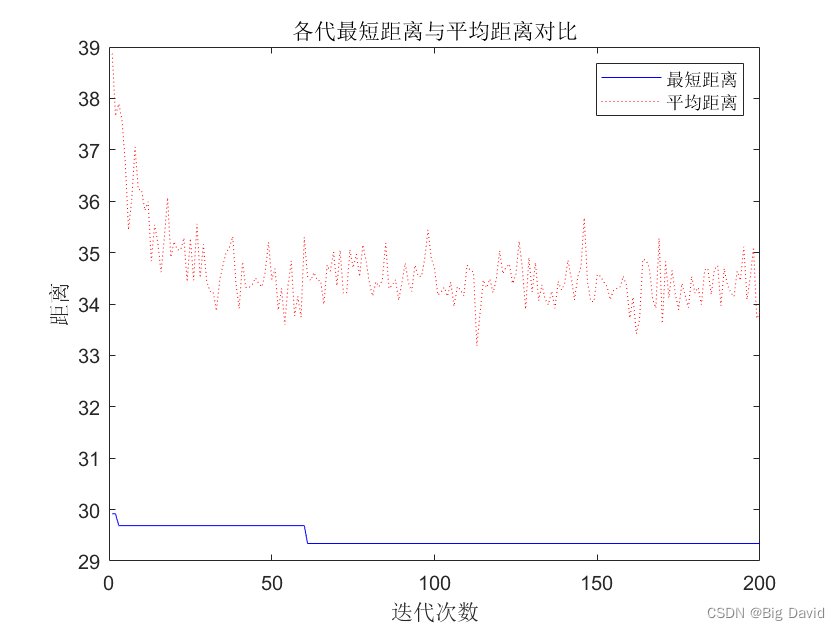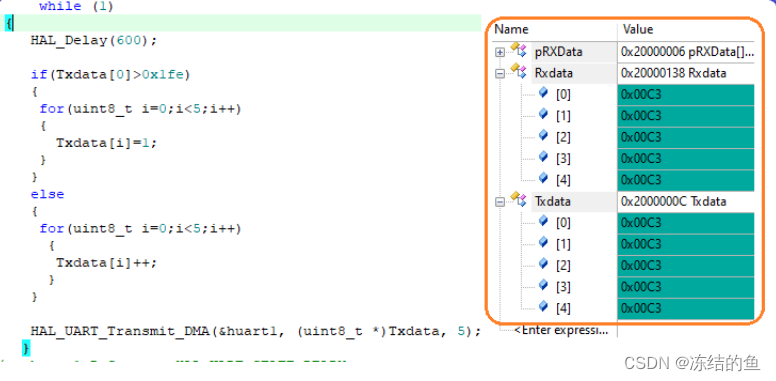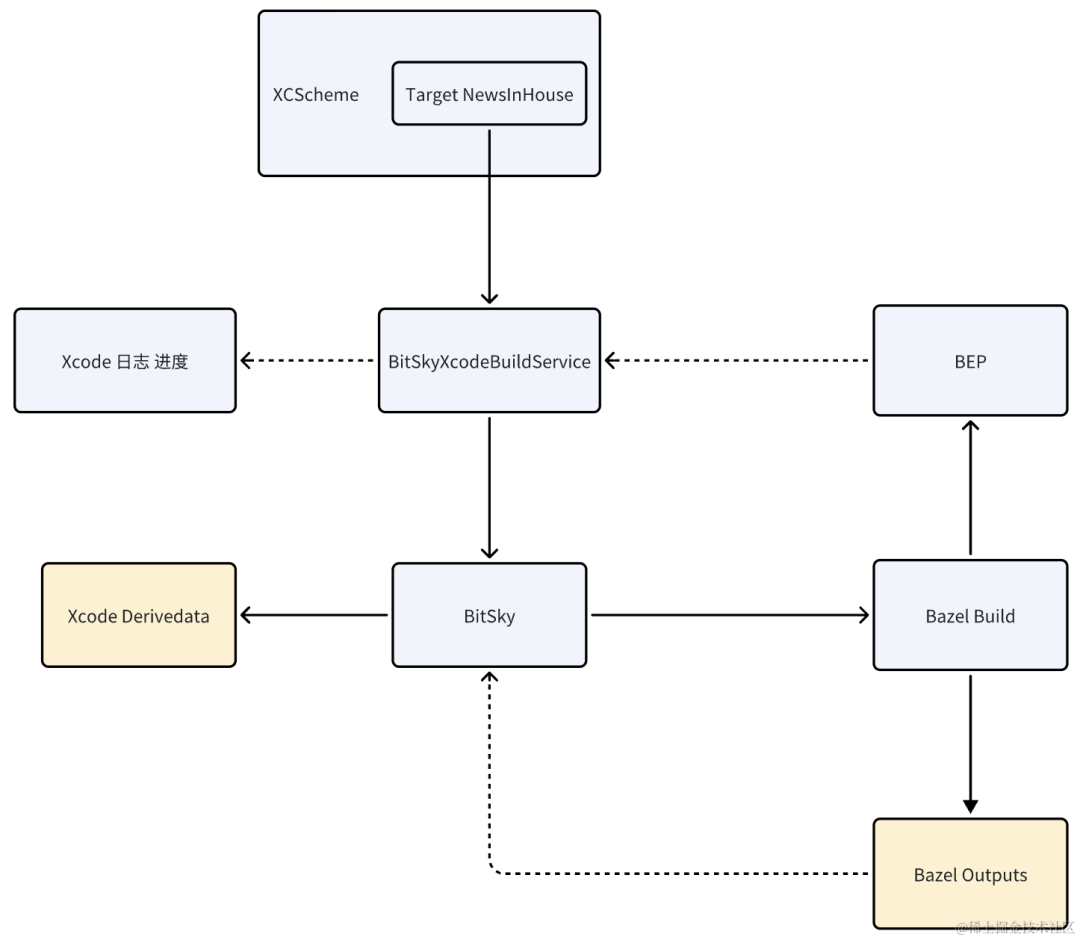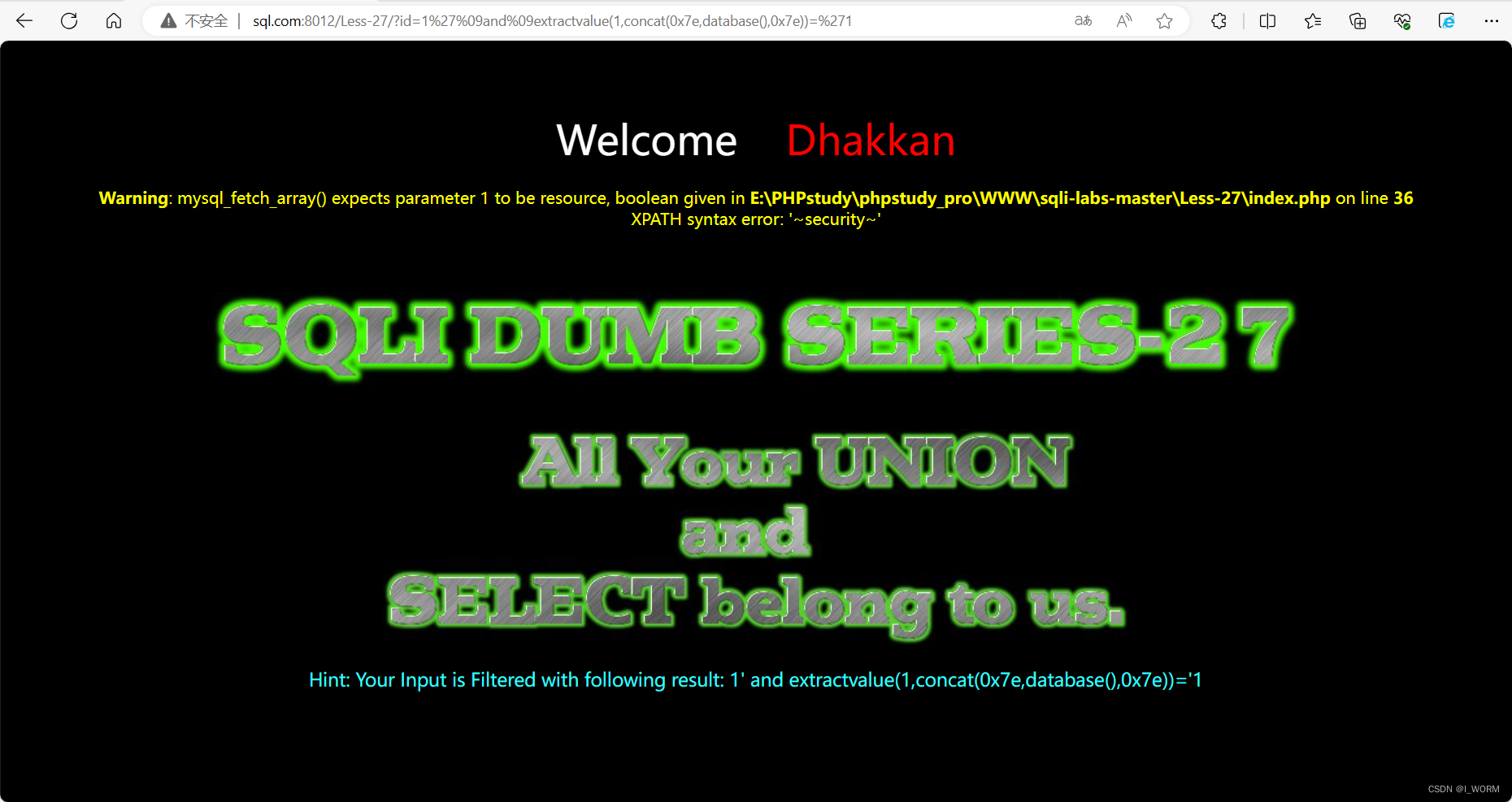文章目录
- MySQL
- 1. 日期函数
- 1.1 查看时间
- 1.2 对时间进行计算
- 2. 字符串函数
- 2.1 字符串查找
- 2.2 字符串修改显示
- 3. 数学函数
- 4. 聚合函数
- 5. 其他函数
MySQL

1. 日期函数
在MySQL中,提供了多种时间函数供我们使用,其中包括用于查看时间的函数和计算日期的函数。以下是一些常用的MySQL时间函数及其描述:
| 函数名称 | 描述 |
|---|---|
| current date() | 当前日期 |
| current time() | 当前时间 |
| current timestamp() | 当前时间戳 |
| date(datetime) | 返回datetime参数的日期部分 |
| date add(date, interval d value type) | 在date中添加日期或时间,interval后的数值单位可以是:year minute secondday |
| date sub(date, interval d value type) | 在date中减去日期或时间,interval后的数值单位可以是:year minute second day |
| datediff(datel, date2) | 两个日期的差,单位是天 |
| now() | 当前日期时间 |
1.1 查看时间
获取当前的年月日:
select current_date();
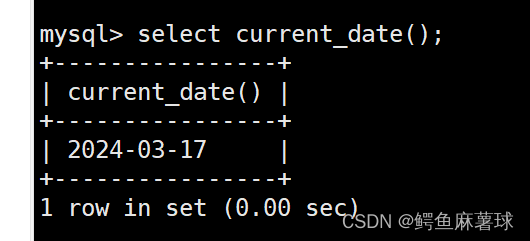
获取当前的时分秒:
select current_time();

获取当前的时间戳:
这里的时间戳相当于是年月日加上时分秒。
select current_timestamp();
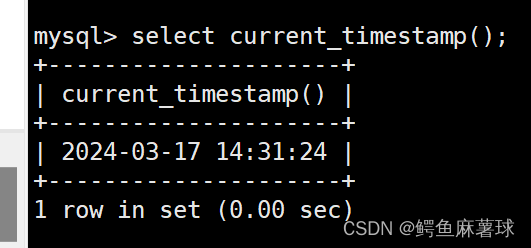
1.2 对时间进行计算
在日期的基础上加日期:
DATE_ADD() 是 MySQL 中的一个函数,用于在日期上添加指定的时间间隔。它的语法如下:
DATE_ADD(date, INTERVAL expr unit);
date 是要操作的日期值。
expr 是希望添加的时间间隔数值。
unit 是时间间隔的单位,例如 DAY、MONTH、YEAR 等。
select date_add('2024-3-17',interval 10 day);

在日期的基础上减去时间:
DATE_SUB() 是 MySQL 中的一个函数,用于从日期时间值中减去指定的时间间隔。它允许你根据需求在日期或日期时间字段中减去年、月、日、小时、分钟或秒钟等时间单位。以下是 DATE_SUB() 函数的基本语法:
DATE_SUB(date, INTERVAL expr unit);
date 是要进行调整的日期或日期时间表达式。
expr 是一个表示时间间隔大小的表达式,可以是一个整数或者一个与 date 类型相同的表达式。
unit 是时间单位,如 YEAR、MONTH、DAY、HOUR、MINUTE、SECOND 等。
select date_sub('2024-3-17',interval 10 day);

计算两个日期之间相差多少天:
DATEDIFF 用于计算两个日期之间的差异。以下是 DATEDIFF 函数的介绍:
DATEDIFF(end_date, start_date);
end_date:表示要计算的时间段的结束日期。
start_date:表示要计算的时间段的开始日期。
select datediff('2024-3-17','2023-3-17');
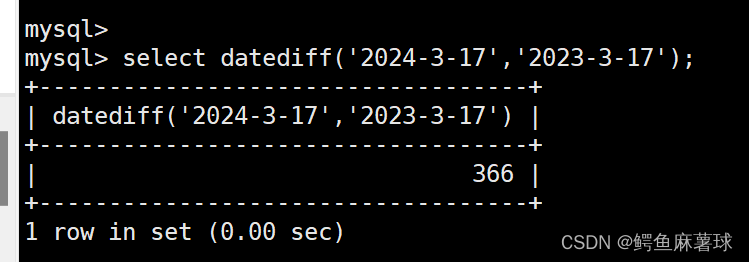
例子:创建一张留言表,用于记录用户发送信息的时间:
我们使用 id 作为主键同时进行自增长,设置内容不为空,同时包含一个 datetime 类型的变量 sendtime 。
mysql> create table msg(
-> id int primary key auto_increment,
-> content varchar(30) not null,
-> sendtime datetime
-> );

打印表结构:
desc msg;
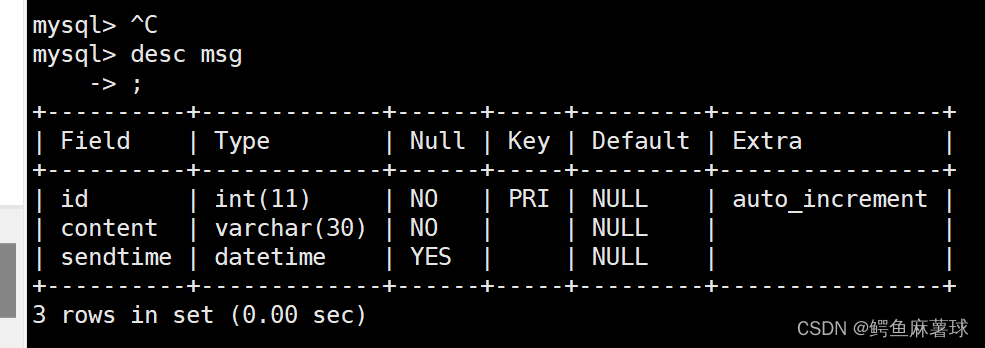
插入数据并且打印所有信息:
mysql> insert into msg(content,sendtime) values('hello',now());
mysql> insert into msg(content,sendtime) values('你好',now());
mysql> insert into msg(content,sendtime) values('你也好',now());

select * from msg;
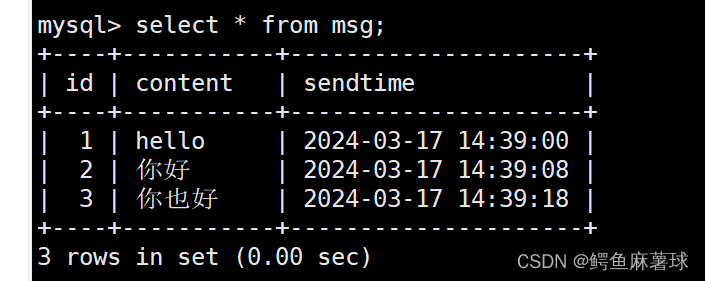
打印所有留言信息,只显示日期,不显示时间:
select content ,date(sendtime) from msg;
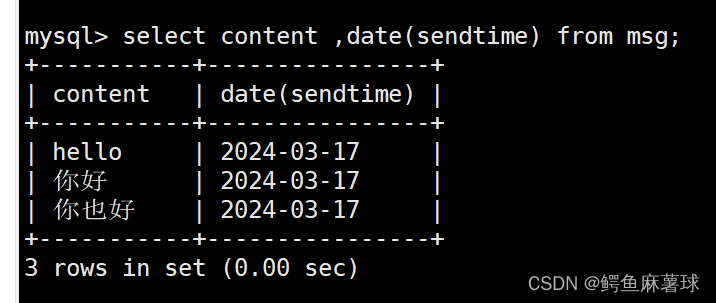
打印所有留言信息,只显示时间,不显示日期:
select content ,time(sendtime) from msg;
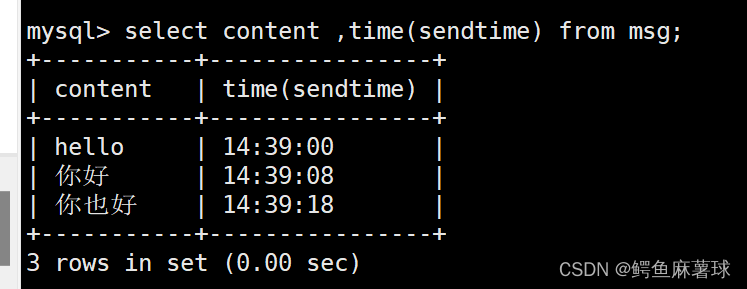
只打印两分钟之内发布的信息:
select * from msg where date_add(sendtime,interval 2 minute)>now();

2. 字符串函数
MySQL 提供了许多字符串函数,用于在查询中处理和操作字符串数据。以下是一些常用的 MySQL 字符串函数及其描述:
| 函数名称 | 描述 |
|---|---|
| charset(str) | 返回字符串字符集 |
| concat(string2[,…]) | 连接字符串 |
| instr(string,substring) | 返回substring在string中出现的位置,没有返回0 |
| ucase(string2) | 转换成大写 |
| lcase(string2) | 转换成小写 |
| left(string2,length) | 从string2中的左边起取length个字符 |
| length(string) | string的长度 |
| replace(str,search str,replace str) | 在str中用replace_str替换search str |
| strcmp(stringl, string2) | 逐字符比较两字符串大小 |
| substring(str,position length]) | 从str的postion开始,取length个字符 |
| ltrim(string) rtrim(string)trim(string) | 去除前空格或后空格 |
2.1 字符串查找
创建一张表其中包括学生的 id 、姓名和语文数学成绩:
mysql> create table emp(
-> id int primary key auto_increment,
-> chinese int comment '语文成绩',
-> math int comment '数学成绩',
-> name varchar(20)
-> );
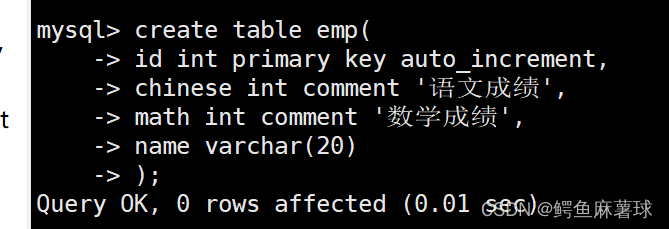
插入学生的信息并且打印查看:
mysql> insert into emp(chinese,math,name) values(90,70,'张三');
mysql> insert into emp(chinese,math,name) values(87,70,'李四');
mysql> insert into emp(chinese,math,name) values(85,80,'王五');
mysql> select * from emp;
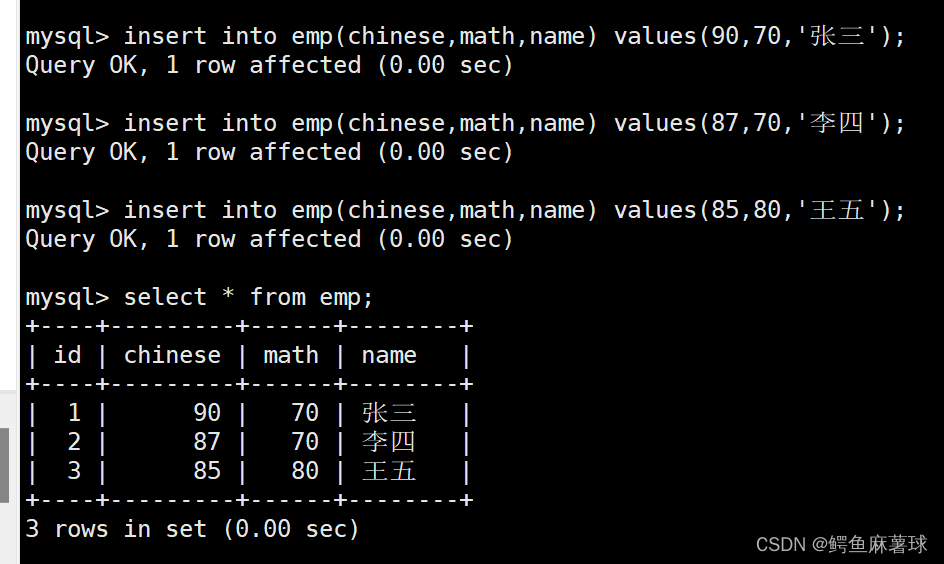
获取emp表的name列的字符集:
select charset(name) from emp;
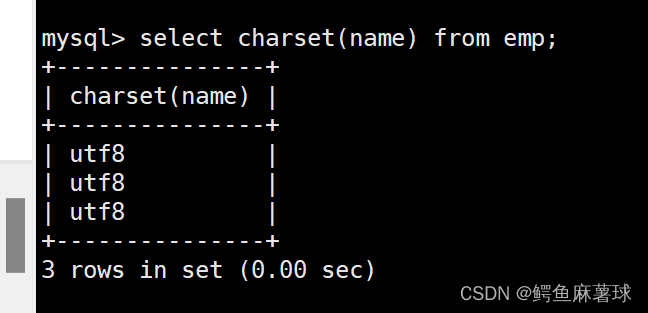
要求显示emp表中的信息,显示格式:“XXX的语文是XXX分,数学XXX分”:
CONCAT函数用于连接两个或多个字符串值,并返回连接后的字符串。这个函数非常有用,特别是当我们需要将多个字段或值组合成一个字符串时。
CONCAT(str1, str2, ..., strN)
str1, str2, …, strN:这是要连接的字符串。它们可以是字符串值、列名、其他CONCAT函数,或者返回字符串值的表达式。
CONCAT函数返回一个字符串,该字符串是输入字符串参数的连接。
select concat(name,'的语文成绩为',chinese,'分,数学成绩为',math,'分')
as '分数' from emp;

求学生表中学生姓名占用的字节数:
因为这里的字符集编码为utf8,utf8中一个汉字占三个字节的大小, 在文段中,name都是两个文字,所以输出的都是6。
select length(name) ,name from emp;
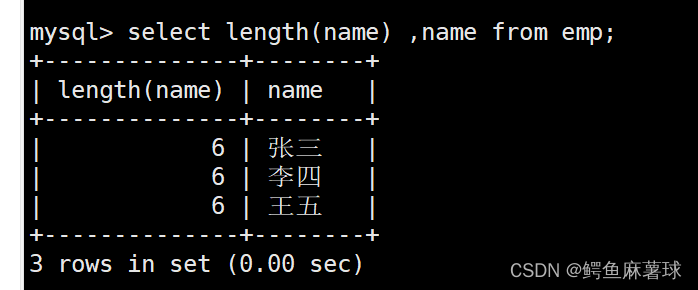
2.2 字符串修改显示
将emp表中所有名字中有 三 的替换成 山:
select replace(name,'三','山'),name from emp;

截取emp表中name字段的第二个到第三个字符:
SUBSTRING 函数用于从一个字符串中提取子字符串。
SUBSTRING(str, pos, len)
str:需要提取子字符串的原始字符串。
pos:开始提取的位置(基于1的索引)。
len:可选参数,表示要提取的字符数。如果省略,将返回从pos开始到字符串末尾的所有字符。
另一种形式:
SUBSTRING(str FROM pos FOR len)
FROM pos:指定开始提取的位置。
FOR len:指定要提取的字符数。
select substring(name,1,1),name from emp;
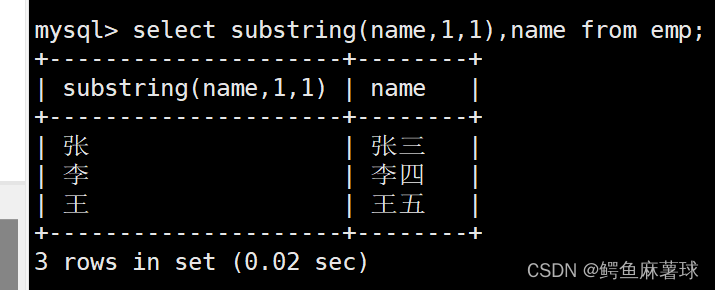
以上对字符串的修改都不会影响到原来的字段信息,只是改变了显示的字符串,若想要更改字段中的字符串,请进行CURD操作。
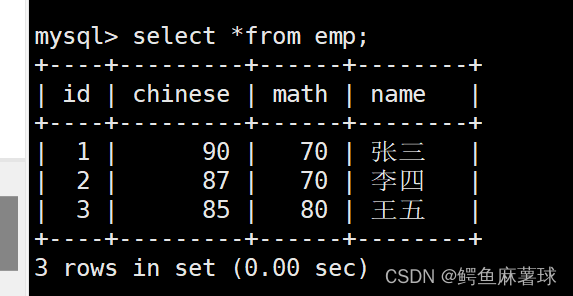
以首字母小写的方式显示所有学生的姓名:
LCASE(或LOWER)函数用于将字符串转换为小写。这个函数在处理大小写不敏感的查询或格式化输出时非常有用。
LCASE(str)
或:
LOWER(str)
其中 str 是要转换为小写的字符串
select concat(lcase(substring(name,1,1)),substring(name,2)) from emp;

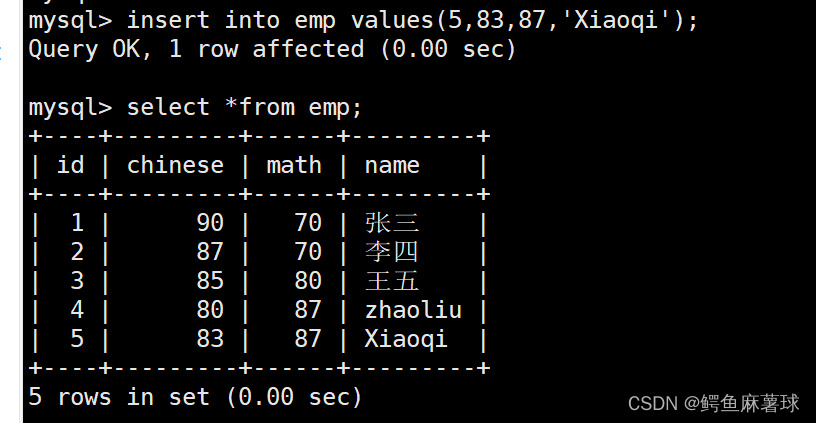

3. 数学函数
MySQL 提供了丰富的数学函数,用于在查询中执行各种数学运算。以下是一些常用的 MySQL 数学函数及其描述:
| 函数名称 | 描述 |
|---|---|
| abs (number) | 绝对值函数 |
| bin(decimal number) | 十进制转换二进制 |
| hex(decimalNumber) | 转换成十六进制 |
| conv(number,from base,to base) | 进制转换 |
| ceiling(number) | 向上去整 |
| floor (number) | 向下去整 |
| format (number,decimal places) | 格式化,保留小数位数 |
| hex(decimalNumber) | 转换成十六进制 |
| rand() | 返回随机浮点数,范围[0.0,1.0) |
| mod(number,denominator) | 取模,求余 |
绝对值:
select abs(-32.4);
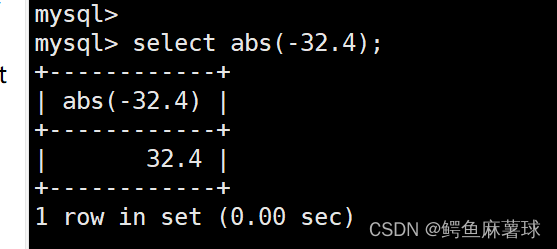
向上取整:
select ceiling(54.3);
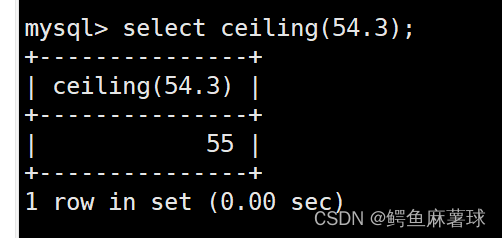
向下取整:
select floor(54.3);
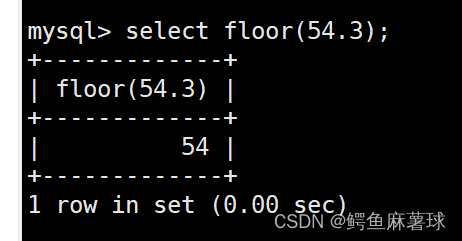
保留2位小数位数(小数四舍五入):
select format(12.34567,3);
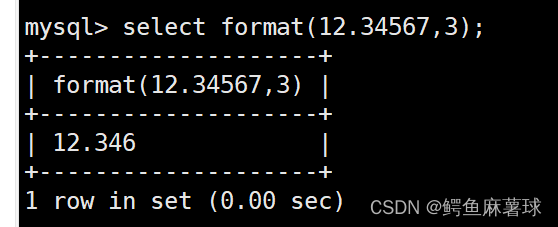
产生随机数:
select rand();
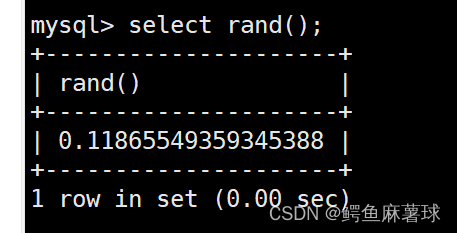
4. 聚合函数
MySQL 提供了多种聚合函数,用于对一组值执行计算并返回单个值。这些函数在数据分析和报告生成中特别有用,因为它们允许你快速总结大量数据。以下是一些常用的 MySQL 聚合函数及其描述:
| 函数 | 说明 |
|---|---|
| COUNT([DISTINCT] expr) | 返回查询到的数据的 数量 |
| SUM([DISTINCT] expr) | 返回查询到的数据的 总和,不是数字没有意义 |
| AVG([DISTINCT] expr) | 返回查询到的数据的 平均值,不是数字没有意义 |
| MAX([DISTINCT] expr) | 返回查询到的数据的 最大值,不是数字没有意义 |
| MIN([DISTINCT] expr) | 返回查询到的数据的 最小值,不是数字没有意义 |
统计学生的个数:
select count(name) from emp;
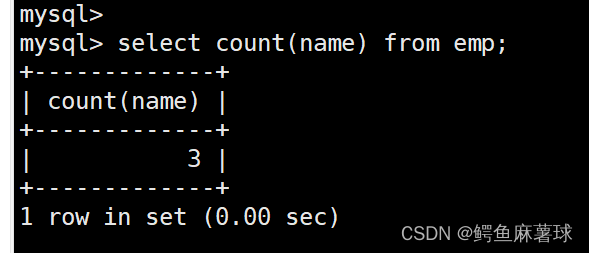
统计学生数学成绩的总分:
select sum(math) from emp;
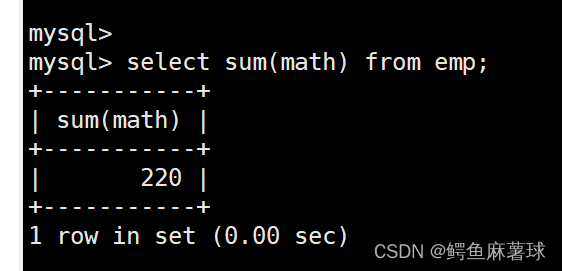
计算学生的平局成绩:
select avg(chinese+math) 平均分 from emp;
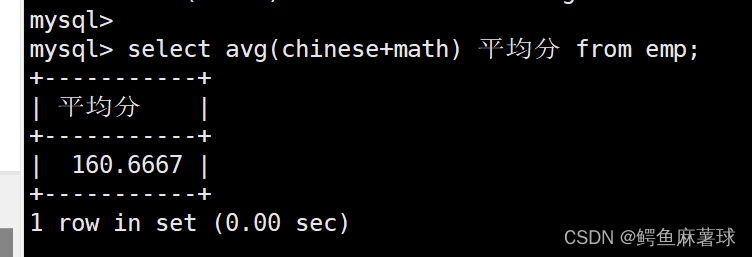
打印数学成绩的最高分:
select max(math) from emp;
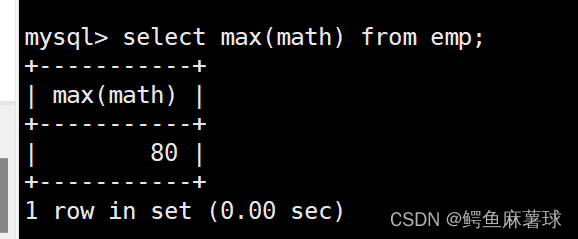
5. 其他函数
查询当前用户:
select user();
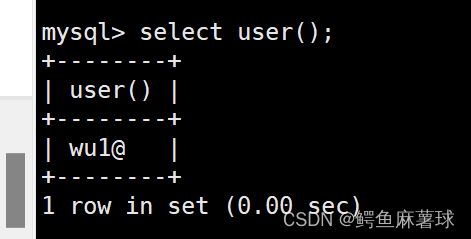
md5(str)对一个字符串进行md5摘要,摘要后得到一个32位字符串:
select md5('admin')
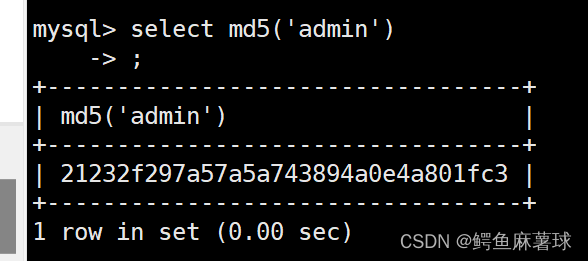
database()显示当前正在使用的数据库:
select database();
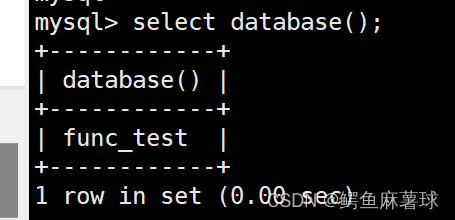
password()函数,MySQL数据库使用该函数对用户加密:
select password('root');
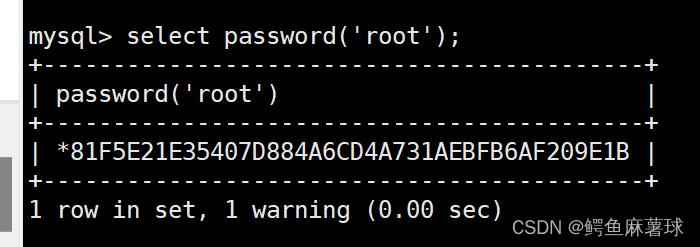
ifnull(val1, val2) 如果val1为null,返回val2,否则返回val1的值:
select ifnull('abc', '123');
